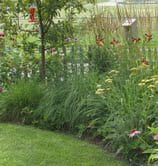by Elizabeth Gross
The best way to create an alternative to the traditional lawn is to practice what my family calls the ‘Pluck & Chuck’ method. I hope you, too, will want to try it.
I try to encourage homeowners to reduce the size of their existing lawn and to encourage weeds to grow within that reduced lawn area. What!? That’s usually what people say, but when people pass our yard and make a point of stopping to tell us how pretty it is, they don’t even realize that they’re complimenting us on this very same concept.
 What we did was increase our landscaping beds in size and in number of plants that offer more ecological benefits. We added many perennials and shrubs that are drought tolerant or that are full of pollen, nectar, berries, seeds or thorns. This way we are helping wildlife with food and shelter, as well as making our yard beautiful to be in and enjoy. Then when I weed the beds, I “Pluck” the weeds out of the landscape beds, & “Chuck” them over my shoulder into the yard. That’s it. The weeds are then mowed like normal once a week and either seed or root in the yard, on their own. They are fast crowding out our grass, yet are low and green so that the “lawn” is still play-on-able and looks neat and tidy from the street or sidewalk. They don’t even realize it’s not grass.
What we did was increase our landscaping beds in size and in number of plants that offer more ecological benefits. We added many perennials and shrubs that are drought tolerant or that are full of pollen, nectar, berries, seeds or thorns. This way we are helping wildlife with food and shelter, as well as making our yard beautiful to be in and enjoy. Then when I weed the beds, I “Pluck” the weeds out of the landscape beds, & “Chuck” them over my shoulder into the yard. That’s it. The weeds are then mowed like normal once a week and either seed or root in the yard, on their own. They are fast crowding out our grass, yet are low and green so that the “lawn” is still play-on-able and looks neat and tidy from the street or sidewalk. They don’t even realize it’s not grass.
 These weeds are so much more helpful to nature than a pure stand of lawn grass. First of all, they don’t require additional watering or pesticide spraying. Second, lawn weeds are the number one source of nectar and pollen for all types of bees in the spring when other plants are not yet blooming. They also feed many different birds and mammals. For instance, common weeds like Dandelions, Purslane, Poa, Wild Strawberries, Violets, Moss, Crabgrass and Clover feed Goldfinches, Towhees, Nuthatches, Buntings, Mourning Doves, Crows, Catbirds, Finches, Thrashers, Cedar Waxwings, Blackbirds, Robins, Juncos, Cardinals, Chipmunks, Squirrels, Deer, Rabbits, Gophers, Woodchucks, and even Butterflies.
These weeds are so much more helpful to nature than a pure stand of lawn grass. First of all, they don’t require additional watering or pesticide spraying. Second, lawn weeds are the number one source of nectar and pollen for all types of bees in the spring when other plants are not yet blooming. They also feed many different birds and mammals. For instance, common weeds like Dandelions, Purslane, Poa, Wild Strawberries, Violets, Moss, Crabgrass and Clover feed Goldfinches, Towhees, Nuthatches, Buntings, Mourning Doves, Crows, Catbirds, Finches, Thrashers, Cedar Waxwings, Blackbirds, Robins, Juncos, Cardinals, Chipmunks, Squirrels, Deer, Rabbits, Gophers, Woodchucks, and even Butterflies.
Did you know that? When I started this, I didn’t. I just didn’t want weeds in my beds looking messy, and I was too lazy to get up and throw them out. But now, that I do know their benefits, I love to watch and see who will come to dine on my “lawn” today, and I’m very happy that we’re using common weeds as a Lawn Alternative. Maybe if everyone’s yard was weedy, everything, everywhere, would be better. I let groundhogs and rabbits into my yard, you ask? Maybe because of the weeds, none of my veggies or flowers have ever been bothered or eaten. We grow corn, tomatoes, watermelon, cucumbers, peppers, pumpkins, eggplant, carrots, raspberries, blueberries, blackberries, strawberries, apples, and grapes. Maybe it’s because they’re already full from eating weeds? We seem to live in harmony.

(Marc and Elizabeth Gross are both Ohio State University Horticulture Graduates and the owners of their family business, Marc Gross Landscaping. Additionally, as a National Wildlife Federation trained wildlife gardener, Elizabeth’s expertise is sought in helping clients transition from traditional landscaping to nature friendly and deer resistant gardens. Often joined onsite by daughter Page, this whole family enjoys creating colorful, easy care, family functional and nature friendly gardens throughout North East Ohio.)

